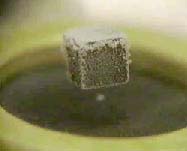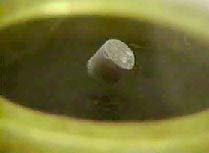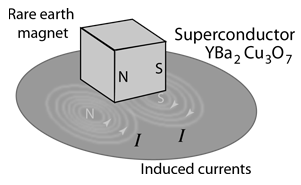The Meissner effect in superconductors like this black ceramic yttrium based superconductor acts to exclude magnetic fields from the material. Since the electrical resistance is zero, supercurrents are generated in the material to exclude the magnetic fields from a magnet brought near it. The currents which cancel the external field produce magnetic poles which mirror the poles of the permanent magnet, repelling them to provide the lift to levitate the magnet.
The levitation process is quite remarkable. Since the levitating currents in the superconductor meet no resistance, they can adjust almost instantly to maintain the levitation. The suspended magnet can be moved, put into oscillation, or even spun rapidly and the levitation currents will adjust to keep it in suspension.
| 

